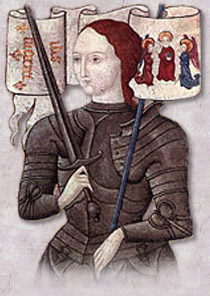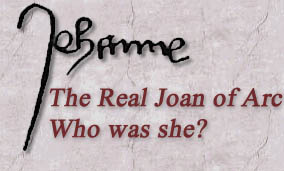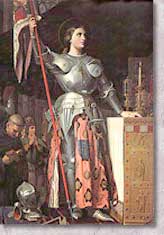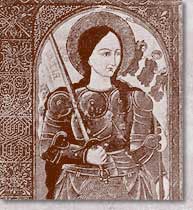|
With monotous regularity
film producers like Besson, or historians, who unfortunately have few
scruples when it comes to portraying a historical figure that they dislike,
do not hesitate to assure us that “ not much is known about Joan of
Arc ”.
The matter had to be investigated. The file below gives answers to the
questions concerning the history of Joan of Arc. Are there means of
knowing her real history through documents ?
Outline :
Introduction : why make a study Joan of Arc ?
1° Sources on Joan of Arc
2° France during the Hundred Years War
3° Chronology of Joan’s public life
4° A woman War Chief
5° Joan’s purity
6° Common sense and humour
7° Sense of mission
Epilogue
Conclusion
Introduction
:
Joan is known worldwide :
studies of her have been made in the USA and Japan. Yet this heroine
is not just the product of a legend as her origins and path are well
known. So there is not much room for extrapolation and imagination if
the need is felt to make a decent study giving due regard to the documents.
The aim of of this article is to prove this point.
Return
to home file
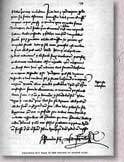 Texts
of the trial
Texts
of the trial |
1°
Sources
Joan’s public life spread
over roughly two years, from 1429 to 1431,
when she was burnt
at the stake on the Old Market Square in Rouen. At the time of her death,
she was about 19 years old. Evidence of her action, her trial and her
execution are available to us through four kinds of sources :
- Joan of Arc’s court trial
: from February to May 1431, Joan was tried in Rouen in the fortress
of Bouvreuil. The sessions of the trial which were at first public
and then in camera, were written Down by notaries who transcribed
both the judges’ questions and Joan’s replies. These Documents were
also called minutes of the trial. Today, historians can read the three
original documents bearing the signatures of the notaries. One of
these documents can be found in the library of the National Assembly
in Paris.
- Nullity or discharge
; such was the tenor of the trial : from 1452 to 1456, the Papal Legate,
Guillaume d’Estouteville, and the grand inquisitor institued an inquiry
to Establish the truth about Joan. For the occasion, 115 witnesses
appeared : childhood Friends, relatives who knew Joan at Domrémy,
her companions at arms, clergy who Recognised her mission in Poitiers
in 1429, the inhabitants of Orléans and the towns which received Joan,
the lawyers and clerks of the court at the conviction trial, assessors
and bourgeois from Rouen who witnessed her death. The investigation
was very carefully led. The diversity of the testimonies make a convincing
portrait of Joan Present day historians are fortunate to have three
original manuscripts which also bear the signatures of the notaries.
- Joan’s letters : like
all war chiefs, Joan had a herald responsible for the communication
of injunctions to the enemy or for taking messages. A dozen letters
have been found, four of which bear Joan’s signature. Other letters
are mentioned in the municipal archives of certain towns.
- Testimonies of chroniclers
and contemporaries of Joan : in Joan’s time, the courts of the grand
princes had official historians who were responsible for the written
records of events. These are the chronicles. Joan’s actions were certified
by several chronicles, letters amongst tradesmen, writers’ accounts
of her time, like the letter writer Christine Pisan who lauded Joan’s
victories
One cannot therefore speak of legend concerning Joan’s life and action.
The Testimonies are so convergent that they give astonishing coherence
to the picture of Joan. A historian relying on his sources was in
possession of a body of information about Joan which left very few
elements in the dark.

The
city of Orléans
Return
to home file
2°
France during the Hundred Years War.
The France of Joan’s time
was in a sad state, judging by the report of the Burgundian chronicler
Georges Chastellain : “ Upside down, the footstool of men, sprain of
the English and the doormat of brigands ! ” From 1330, France was at
war against England for the duration of what was called the Hundred
Years War. In fact it lasted for 115 years (1338 to 1453), but the battles
were actually fought with numerous intervals for truces.
When Joan came
on the scene in 1429, the situation had never been so critical. Indeed,
the war started up again, as often so sadly happens in France, as the
result of civil war. The French were divided into two camps :
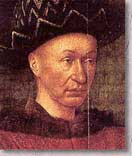
The
king Charles VII |
The Burgundians were in control
of Paris. Their leader, the powerful Duke of Burgundy Philip the Good,
had decided on an alliance with England. The English had invaded Normandy
and the whole of the North of France and also had possession of the
Duchy of Guyenne. Since the treaty of Troyes in 1420, the English dynasty
was assured the rule of France as Charles VI, who had gone mad, had
disinherited his son, the future Charles VII, in favour of his daughter
Catherine of France who had been given in marriage to the King of England,
Henry V.
The Armagnacs’ had as leader the Duke Charles of Orléans who had been
captured by the English and held prisoner by them for 25 years. This
party supported the Dauphin Charles who had been disinherited. All in
all, the man the Burgundians scornfully called the King of Bourges only
had power over a quarter of South Western France, excluding Guyenne.
The bridgehead, the gateway to the South West was Orléans. By besieging
the city the English intended to put an end to the Dauphin as once this
last passage on the Loire was removed, there would be no further obstacle
until Bourges. This shows how desperate the situation was.
Return
to home file
3°
Chronology of Joan’s public life
Joan’s life and
mission were very short : she died at the age of 19, her public activity
lasted only just two years, from February 1429 to 30 May 1431. These
two years can be divided into two periods : one year at war and one
year in captivity :
1. Military exploits
1428
During July of this year, the English troops attacked Vaucouleurs. Joan
and her family left Domrémy and took refuge at Neufchâteau because of
the insecurity of the region. The “ place de Vaucouleurs held out.
1429
- 12 February :
French defeat at Orléans. Captain Robert Baudricourt gave Joan permission
to leave for Chinon to meet Charles, the Dauphin.
-22 February to 4 March : Joan’s journey to Chinon Until 11 March :
meeting with the Dauphin.
- 11 to 24 March : Joan was in Poitiers to have her mission ratified
by a clerical commission. End of April : After setting up her military
base, Joan left for Orléans.
- 8 May : The English, after being defeated, lifted the siege.
- 18 June : English defeat at Patay. The road to the coronation was
open.
- 17 July : Coronation of Charles VII at Reims. From July to September
: Joan’s campagne to march on Paris.
- 10 September : The king gave the order to give up the attack on Paris.
The army was dissolved. November : The taking of Saint Pierre Le Moûtier
but failure to take la Charité sur Loire.
1430
February and March : Joan spent the winter at Sully sur Loire.
From March to May : Joan resumed her march towards Paris.
2. Period of Captivity
-23 May : Joan was taken prisoner by the Burgundian, Jean de Luxembourg
under the ramparts of Compiègne.
- 11 July to beginning of November : Joan was locked up in the château
de Beaurevoir where she attempted to escape by jumping from a tower.
In the mean time Jean de Luxembourg sold his prisoner to the English
for 10 000 pounds (livres tournois).
- From November to December : Joan was transferred from the château
du Bouvreuil to Rouen.
1431
-January : Investigation ordered by Pierre Cauchon to Domrémy and Vaucouleurs.
- 13 February : Constitution of the tribunal.
- February to March : Court trial.
- End of March : Drawing up of 70 articles condemning Joan. April :
Deliberations of the Doctors. Attempted poisoning.
- Beginning of May : Threat of torture.
- 24 May : In the cemetery of Saint Ouen, Pierre Cauchon forced Joan
to abjure. T give proof of her submission, Joan again dressed as a woman.
- 28 May : Joan put on masculine clothing once again. For this reason
alone, she was deemed to have relapsed and this led to her death sentence.
- 30 May : Joan was burned alive on the Old Market Square in Rouen
Return
to home file
4°
A woman at the head of the Army
How could
the simple daughter of a labourer who had never left her village become
a chief of staff in the army who was held in esteem by her companions
at arms and feared by her enemies ?
Indeed, Joan’s childhood could never have explained how she should come
to have such a destiny. All extant testimony is in agreement on this
point . Joan’s own testimony given at her trial and sentencing to death
was confirmed by that of inhabitants of Domrémy, of her mother, her
gocfather as well as childhood friends. Joan was just an ordinary girl
like others of her time, except for her extreme piety, which gave rise
to teasing from the boys of her age. Her childhood friend, Hauviette,
related very simply her memories of Joan :
“ Joan was
a kind, humble and gentle girl ; she went often and willingly to church
et holy places and she was often embarrassed at the way people said
she went so piously to church(…) She kept busy as other girls do, doing
housework and sometimes spinning - I saw her - she minded the flocks
like her father did. ”
There is nothing exceptional
to be found in Joan’s childhood. This ordinariness can be irritating
because one would like to know more. The investigation ordere by judge
Pierre Cauchon would certainly have brought to light the slightest details
which could have influenced Joan in her decision to go to Chinon. There
was never any question in any of the documents, of any violence committed
on her little sister, Catherine. If such had been the case, the judges
would have made use of it to turn it against her. Had they not gone
as far as to ask Joan to explain why she had allegedly broken her promise
to marry ? Her entire past had been thoroughly investigated. When considering
the evidence of the witnesses, one has to note that this young, apparently
simple girl had an extremely strong will and extraordinary force. From
January 1429, she tried to persuade the Captain of the “ place de Vaucouleurs
” to allow her to go to meet the Dauphin at Chinon. Her cousin Durand
Laxart, who had gone with Joan, gave evidence that the captain had asked
him to slap her ! No matter ! Joan made the same request twice more.
She managed to convince the captain when she told him of the defeat
of the French on the day of the Harengs. This defeat had just happened.
The news had not yet been announced. The captain was so astonished by
this premature announcement that he gave her equipment and an escort.
Having convinced the Dauphin at Chinon, Joan became the authentic chief
of the army, had military quarters and a horseman, a steward and a messenger
to take her messages. The Duke of Alençon, who became her companion
at arms, was amazed by her skill on horseback and in handling a weapon.
He even gave her a horse as a gift.
Joan’s action quickly became powerfully efficient. After gathering together
her army, she left for Orléans, protected by Captain Dunois, nicknamed
the bastard of Orléans as he was the half-brother of Duke Charles, imprisoned
in England. Joan imposed respect and managed, not without difficulty,
to take command of her army. In ten days she slayed the English in the
East of the city and freed the bridge over the Loire in the course of
the day of Tourelles, where she was wounded. This victory brought about
the lifting of the siege as the chief of the English company was killed
in the battle. From 8 May until 18 June, she won back the forteresses
and towns on the banks of the Loire. On 18 June, Joan’s army won its
first campagne victory. Since the beginning of the Hundred Years War,
the defeat of Poitiers, of Crécy and of Azincourt had covered the French
cavalry with shame. Patay was thus the much awaited revenge which restored
confidence and at the same time opened up the road to Reims for Charles
to be crowned there.
Joan conducted the war in an entirely new way, at a tume when the savagery
of battles had broken all the rules of God’s Peace. Of course baudy
wenches and other girls of possibly doubtful virtue were not allowed
to follow the army. Priests carrying banners recited prayers and heard
the confessions of the soldiers. Joan’s companions at arms, rough men
of the road noted for their propensity for rape and their exactions
(one of these companions of Joan, Gilles de Rais, was hanged for rape
and pilfering), held her in such esteem that it was close to veneration.
They had to change their behaviour and language when in her presence.
Return
to home file
5°
Joan’s Purity
In the rough
and tumble of the times, these men were impressed by Joan’s purity.
Joan’s virginity is a proof of the authenticity of her mission. She
claimed her title of « Maid of Orléans » for herself ; it was the only
name by which she was called by her contemporaries. Today, we find this
term very strange, if not ridiculous. Yet, on two occasions, Joan’s
virginity was noted by mature women, at Poitiers in March 1429 but also
at Rouen, on 13 January1431. Pierre Cauchon had ordered this second
investigation in order to find a major charge against Joan. In vain.
Several pieces of evidence converge in this regard. When Joan went on
horseback from Vaucouleurs to Chinon, her escort who shared her camping
was impressed. Gobert Thibault, a royal squire gave evidence : « In
the army, she was always with the soldiers ; I heard it said by some
of those close to Joan that they had never been tempted to seduce her.
»
Return
to home file
6°
Common sense and good sense of humour.
Joan’s common sense
was another sign of the integrity of the person. Joan was not a crank
detached from reality by her supernatural visions, on the contrary.
She had her feet firmly on the ground . When she was questioned in Poitiers
by some clerics about her mission, a Dominican called Seguin Seguin
was impressed by the clarity of her replies, her confidance and sincerity.
He was, in addition, surprised by Joan’s humour : « I asked her what
kind of language her voices spoke. She answered « Better than yours.
» I spoke the language of Limousine : and again I asked her if she believed
in God : she answered : « Yes, better than you. »
Later, during the prosecution trial, the judges had a hard time with
her. From the start, the preliminary investigation ordered by Pierre
Cauchon could not make any case against Joan. So the trial had to start
without any motive. Joan was thus condemned solely on the grounds of
her own words. She had no advocate. She had to defend herself and her
defense was good, never contradicting herself and maintaining total
coherence with all she said from beginning end. Let us see for ourselves
in the interrogation of 1 March 1431 :
"- What did Saint Michael look like, when he appeared to you ?
(…) Was he naked ?
-Do you think God can’t clothe him ?
-Did he have hair ? Why wa s it cut ?
-Did he have weighing scales ?
-I don’t know (…) I experience deep joy when I see him… "
So what were the reasons for her condemnation ? There was an attempt
to catch her out by drawing up 70 false articles contradicting Joan.
On reading these articles, it was hoped that Joan would be caught out,
but she stood firm. Let us take the example of article 7.
"Joan was said to have worn a mandrake round her neck in the hope
she would thus have great wealth in temporal things ; maintaining that
a mandrake of this sort was powerful and active. "The notary kept
the following reply of Joan in his report : "This article about
the mandrake, she denies emphatically. "
The judges then tried to scare her by showing her the executioner and
the torture chamber. This was a sheer waste of time : "Really,
she said, if you were to tear my limbs from my body and separate my
soul from it, I would not say anything different. And if I did say something
different, I would afterwards say that you had made me say it under
duress. "
There remained only one argument : the male dress. Joan did not submit
to the Church because she wore male dress which was forbidden. Taking
into account that she was guarded in her prison by three English male
soldiers, that her feet were in leg irons and that at night her chains
were fixed to a heavy wooden beam, it is not difficult to understand
that this garb was a protection. On 24 May 1431, Cauchon rigged a scenario.
Joan appeared in the cemetery of Saint Ouen before her judges. She was
summonsed to obey the Church by signing a schedule to abjure. If she
refused, she was condemned. Joan submitted, promised to obey the Pope
and to dress in female garb. On the paper on which she was to deny her
voices, she traced a simple cross in a circle. Now, Joan knew how to
sign her name. In the military code this sign meant that the order was
not to be carried out. Back in prison, Joan dressed as a woman again.
But, during the night, her guards stole her new clothes and only left
her the old ones. Cauchon found this pretext to accuse her of relapse
(returning to her wrongful ways) and hurriedly condemned her to death.
Return
to home file
7°
Sense of her mission
For the modern
reader, this last part raises questions. Divine intervention in History
upsets a rational understanding of the facts and events. However, in
spite of all Pierre Cauchon’s zeal, it was not possible to condemn Joan
on the grounds that she heard voices, or that she was a crank or mentally
unstable He never succeeded in proving the slightest incoherence. Joan
never contradicted herself. So, what then ?
At Poitiers, this
is how Joan related her vocation : "When she was minding the animals,
she heard a voice who told her that God was weeping over the people
of France and that she, Joan, must come to France. When she heard this
she began to cry ; then the voice told her to go to Vaucouleurs where
she would find a Captain who would lead her safely to France and to
the King ; she was not to doubt this. This is exactly what she did and
she went straight to the King without any hindrance. "She gave
this account on several occasions before the judges without contradicting
herself, in spite of their snares. She refused to go back on her account
of the voices and insisted that, even if she died, the English would
be chased out of France...
"I know that the English will have me put to death because they
think that after my death they will conquer the kingdom of France. But
even if there were a hundred thousand more of them than at present,
they will not take the kingdom. "
And this is exactly what happened after her death… The English did indeed
crown the young Henry VI in the cathedral of Paris in 1432. But this
symbol did not rally the French and did not prove a victory. In 1435,
the Armagnacs and the Burgundians were reconciled. In 1436, Paris rejected
the English. Normandy which had been thoroughly pillaged rose up in
1449 (Rouen had about 14 000 inhabitants at the time of the English
conquest, but only 5 000 inhabitants remained afterwards). The English
were beaten at Formigny in 1450, then at Castillon in 1453. They had
to hand over the duchy of Guyenne which had belonged to them since Eleanor
of Aquitaine… The best proof of the authenticity of Joan’s mission is
indeed that all her prophecies came true.
Return
to home file
Epilogue :
On 30 May 1431 the day ended in an extremely sinister way in the fine
city of Rouen. Yet, the English should have rejoiced as their worst
enemy was dead. The executioner who had been called upon to torture
her in the dungeon of Rouen reported the following:
"Once she was in the fire, she cried out more than six times «
Jesus ! » And especially, with her last breath, she cried out in a loud
voice « Jesus ! » Her cry was so loud that all those present could hear
her ; almost all were moved to tears. "
A builder who had done several jobs in the château where Joan was imprisoned
and judged and who had seen her on several occasions, also related :
"I heard the secretary of the King of England, master Jean Tressart,
weeping and groaning with sorrow, and saying, on coming away from Joan’s
torture, that after what he had seen there : « We are all lost, for
the girl who was burnt was a good and holy person ». He thought that
her soul was in the hands of God and that when she was engulfed in flames,
she continued to proclain the name of the Lord Jesus. "And so the
deep sense and meaning of Joan’s life were expressed in her last moments.
Return
to home file
Conclusion
:
The problem that Joan presents
to the historian and to History itself is the same as the one presented
by Jesus of Nazareth. From start to finish, Joan claimed that she had
received her mission from God, that she had obeyed her voices and that
she would rather die than renounce her mission. Jesus claimed to be
the Son of God.
In Joan’s case, if we refuse to accept what she said of her mission,
we see her as a lunatic, unbalanced, a pale figure burnt at the stake
on the Old Market Square of Rouen.
But in this case the sources have to be rejected and the Joan presented
does not correspond to the figure that stands out in the various pieces
of evidence. Joan would then be put on trial a second time, which would
be ridiculous since she has already been judged. This is precisely what
Luc Besson’s film does, backed up by a substantial amount of dollars.
This is the image of Joan that is being widespread in the global village
by the powerful means of the cinema. In many respects, this image is
intolerable as it is a false image.
It has to be said that, in this case, truth is indeed finer than fiction
Return
to home file

|
